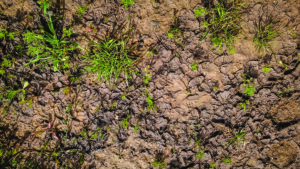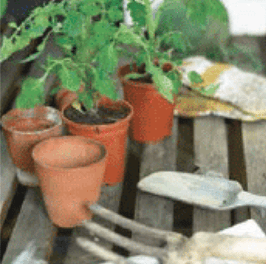
Tilling wet soil can cause it to become cloddy and brick-hard when it dries out. Try your best to refrain from walking on your garden beds. It will likely lead to compaction, which can impede root penetration and cause poor drainage.
Spring is almost here! Usually, this is the time of year where we get a little eager to be out and in the garden, but March can be deceptive.
It’s important to exercise patience and there’s still plenty of things to do before the ground is ready for planting.
• To-Do List: Attend a local gardening event, such as the four events Robin’s Nest is hosting this month! Join us for a different indoor gardening workshop each Sunday in March. We’ll be having an orchid repotting workshop, houseplant party, miniature gardening workshop, and cacti & succulents workshop. There’s no admission fee — you only pay for the supplies you use. If you’re interested, you can RSVP on our Facebook page! Come hang out with other plant lovers while learning about plant care and requirements, and more importantly — have fun with plants.
Weed, weed, weed! If you really want to get outside, here’s your first step. Remove those wretched winter weeds that have taken over your garden beds.
If you tend to garden directly out of the ground, you might want to consider raised beds — as now is a great time to build them. Raised beds provide better drainage, warm up quicker in the spring, minimize the compaction of soil, and are awesome for root crops. If your garden plans are complete, you can place trellises as well.
Organization and prep will help tremendously once it’s time to plant. If you have seeds picked out or ordered, try organizing them in the order you plan to plant them in.
If you’re up for a tougher job, redefining the edges of your garden beds will help prevent grass from overtaking the already established edges.
Additionally, when cutting your daffodils for indoor floral arrangements, make sure to not combine them with any other flowers in a vase. They give off a toxic substance that has the potential to kill your other blooms prematurely.
• To-Not List: Unless we have a dry March and have had a dry February, turning over soil is just going to compound structural problems.
Tilling wet soil can cause it to become cloddy and brick-hard when it dries out. So, try your best to refrain from walking on your garden beds. It will likely lead to compaction, which can impede root penetration and cause poor drainage.
If you’re feeling antsy to plant right now, again, consider how cold and wet the soil is.
Seeds and tubers are both more likely to rot in these conditions. So, consider starting your seeds indoors if you’re eager to get going.
A great way to check your soil is to ball some up in your hand, then bounce it in your hand a few times. If the soil breaks apart easily, then it’s likely all right to start digging.
• Keep Your Houseplants Happy: It’s about time to start watering houseplants a little more frequently than you have been throughout winter.
The gradual increase in daylight hours and warmer temperatures will likely impact how often your plants need water. Gradually increase your watering frequency to prevent overwatering.
Now that the sun is getting stronger as days are getting longer, you may need to consider relocating some plants away from the window. Some might need to be moved further into your space, or have a sheer curtain drawn to diffuse the sun’s rays — this will help avoid leaf burning.
Similar to increasing your watering frequency, decreasing light should be another gradual process. Don’t forget some plants, such as succulents and cacti, probably won’t need to be moved because they thrive in bright, direct light.
Plants typically need to be repotted every 12 to 18 months. Spring is one of the best times to do so to provide plants with new nutrients and/or more space for the growing season ahead. Some plants aren’t a fan of repotting and could go into shock, so make sure you’re only doing it for those that absolutely need it. Several common signs that a plant needs to be repotted include roots breaching the bottom of the pot or the top of the soil, water running through the soil without soaking in, or if you pull the plant up and the roots are circling the bottom of the pot.
As mentioned in our last article, it’s also about time to start fertilizing your houseplants. It’s important to remember fertilizer isn’t food for your plants: plants make their own food using light during photosynthesis. Instead, think of it more like a multi-vitamin. It replaces essential nutrients in the potting mix that are used up as a plant actively grows, so fertilizer should be used sparingly and never in fresh soil.
Remember, even though it may be starting to warm up, the ground probably isn’t quite there yet.
So have patience, and take care of your garden and houseplants in the way that works best for you this month.
(Editor’s Note: Ken Morgan is the owner of Robin’s Nest Floral and Garden Center in Easton, Md.)




